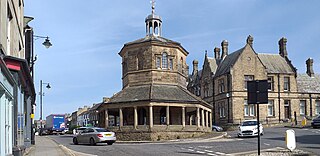
Barnard Castle is a market town on the north bank of the River Tees, in County Durham, England. The town is named after and built around a medieval castle ruin. The town's Bowes Museum's has an 18th-century Silver Swan automaton exhibit and paintings by Goya and El Greco.

Lartington is a village and civil parish about 2 miles (3 km) west of the town of Barnard Castle, in Teesdale, in the Pennines of England. The 2011 Census recorded the parish's population as 135.

Hylton Castle is a stone castle in the North Hylton area of Sunderland, Tyne and Wear, England. Originally built from wood by the Hilton family shortly after the Norman Conquest in 1066, it was later rebuilt in stone in the late 14th to early 15th century. The castle underwent major changes to its interior and exterior in the 18th century and it remained the principal seat of the Hylton family until the death of the last Baron in 1746. It was then Gothicised but neglected until 1812, when it was revitalised by a new owner. Standing empty again until the 1840s, it was briefly used as a school until it was purchased again in 1862. The site passed to a local coal company in the early 20th century and was taken over by the state in 1950.

Allerton Castle, also known as Allerton Park, is a Grade I listed nineteenth-century Gothic or Victorian Gothic house at Allerton Mauleverer in North Yorkshire, England. It was rebuilt by architect George Martin, of Baker Street, London in 1843–53.

Appleby Magna is a village and civil parish in the North West Leicestershire district, in the county of Leicestershire, England. It includes the small hamlets of Appleby Parva and Little Wigston.

Cliffe is a small village and civil parish in Richmondshire district of North Yorkshire, England. A stream called the Glen runs through the village to the Tees. It is in the Teesdale and Yorkshire Dales national park. It is about 6 miles (10 km) west of Darlington, 10 miles (16 km) north of Richmond and near Piercebridge.

Chavenage House, Beverston, Gloucestershire is a country house dating from the late 16th century. The house was built in 1576 and is constructed of Cotswold stone, with a Cotswold stone tiled roof. David Verey and Alan Brooks, in their Gloucestershire Pevsner, describe the house as "the ideal sixteenth-century Cotswold stone manor house". Chavenage is a Grade I listed building.
There have been six baronetcies created for persons with the surname of Lawson, two in the Baronetage of England and four in the Baronetage of the United Kingdom. Two creations are extant as of 2010.

Overseal is a village and civil parish in South Derbyshire district of Derbyshire, England. It is 3 miles (4.8 km) south of Swadlincote, 5 miles (8.0 km) west of Ashby-de-la-Zouch and 13 miles (21 km) south-southwest of Derby. It had a population of the civil parish at the 2011 census was 2,450. Situated within the National Forest area, it is near the villages of Netherseal and Lullington as well as being close to the border with Leicestershire. It is one of the southernmost settlements in Derbyshire.

Minsteracres is an 18th-century mansion house, now a Christian retreat centre, in Northumberland, England. It is a Grade II listed building.

Bishopwearmouth Cemetery is a cemetery in Sunderland, Tyne and Wear, England. It lies between Hylton Road and Chester Road.

Bankfield Museum is a grade II listed historic house museum, incorporating a regimental museum and textiles gallery in Boothtown, Halifax, England. It is notable for its past ownership and development by Colonel Edward Akroyd, MP, and its grand interior.

Witham Hall is an independent boarding and day school situated in Witham on the Hill, Lincolnshire, England.

Henry Thomas Maire Witham FRSE FGS (1779–1844) was a British landowner remembered as an amateur palaeontologist and mineralogist.
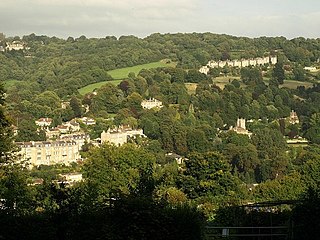
Crowe Hall is a Georgian house in Widcombe, Bath, Somerset, England. It is a Grade II listed building, and the gardens are on the Register of Historic Parks and Gardens of special historic interest in England.
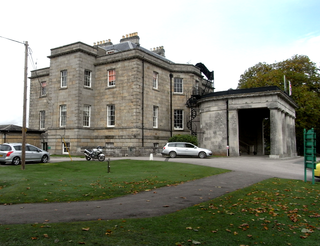
Stover is a historic estate in the parish of Teigngrace, about half way between the towns of Newton Abbot and Bovey Tracey in South Devon, England. It was bought by James Templer (1722–1782) in 1765 and passed through three generations of that family before being bought by Edward St Maur, 11th Duke of Somerset in 1829.

Elvetham Hall is a hotel in Hampshire, England, in the parish of Hartley Wintney about 2 miles (3 km) northwest of Fleet. The building is a High Victorian Gothic Revival English country house and a Grade II* listed building. It stands in a landscaped park that is Grade II listed.
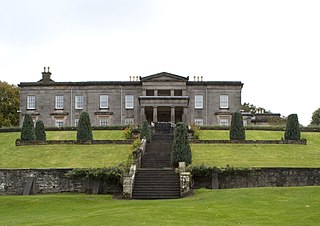
Aberlour House is a country house near Aberlour in Moray, Scotland. It was built in 1838 by William Robertson for Alexander Grant, planter and merchant from Aberlour, after his return to the UK. His niece, Margaret Macpherson Grant, lived in it after Grant died, and it was later home to John Ritchie Findlay of The Scotsman newspaper and his descendants. It was requisitioned for military use during the Second World War, and after the war was sold for use as a preparatory school for Gordonstoun. The school was later moved into Gordonstoun's estate, and the building was sold to Walkers Shortbread, who restored and renovated it, and now use it as their head office. It has been designated a Category A listed building.
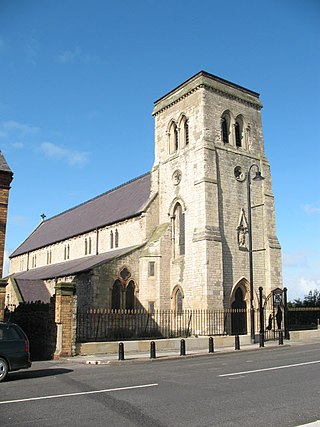
St Mary's Church or the Church of the Immaculate Conception is a Roman Catholic Parish church in Headland, Hartlepool, County Durham, England. It was built in 1850 and designed by Joseph Hansom in the Gothic Revival style. It is located on Durham Street, behind Hartlepool Borough Hall. It was the first Catholic church to be built in Hartlepool since the Reformation, and it is a Grade II listed building.
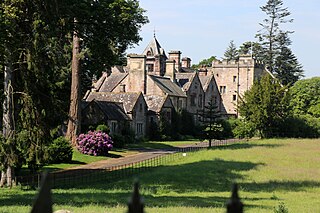
Crossrigg Hall is a country house in the civil parish of Bolton, Cumbria in the northern United Kingdom. It was built in 1864 by Lieutenant Colonel Hugh Rigg of the Indian Army's Madras Infantry. Designed by Anthony Salvin, and with later additions by J. H. Martindale, the hall is a Grade II* listed building.





















